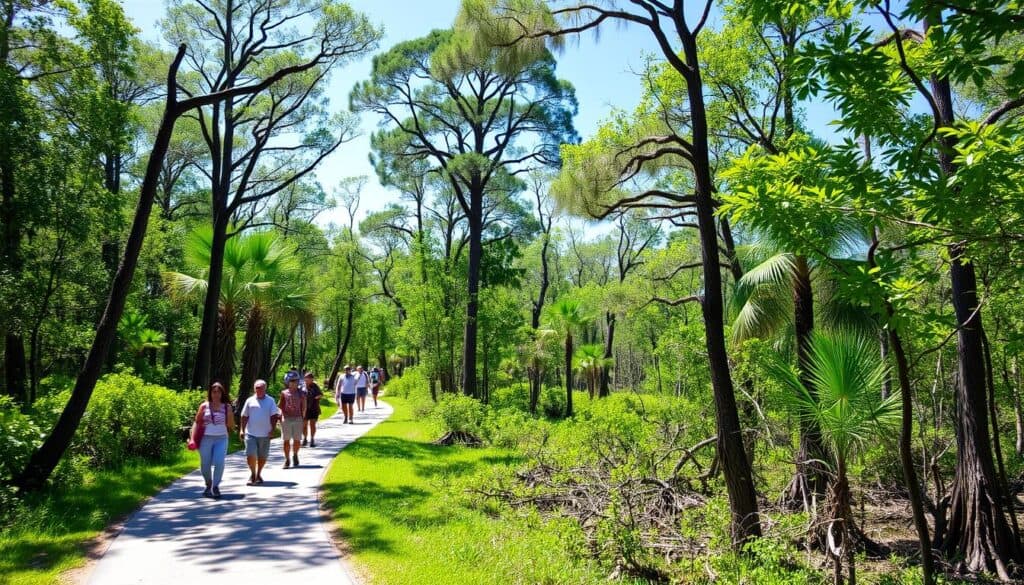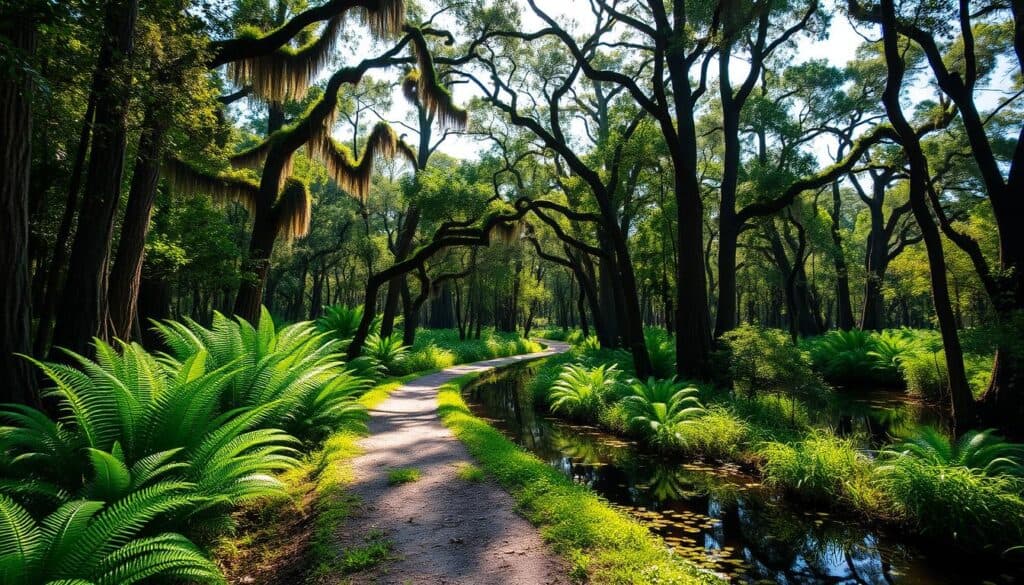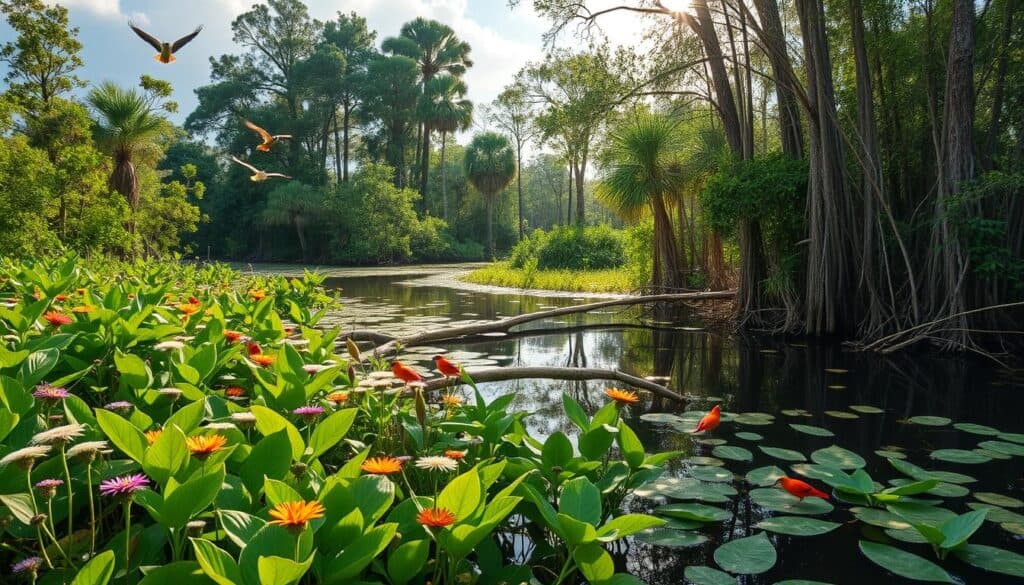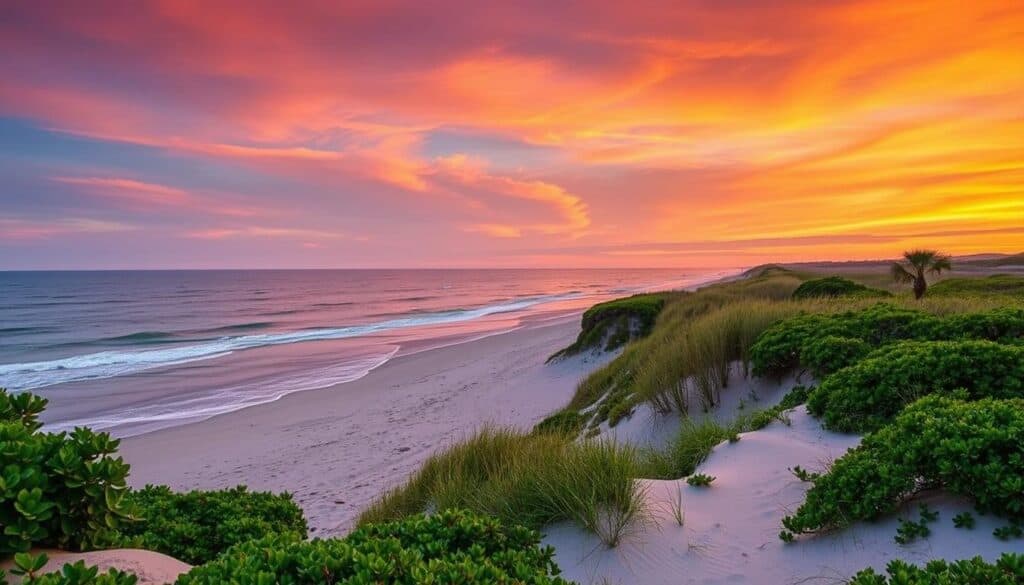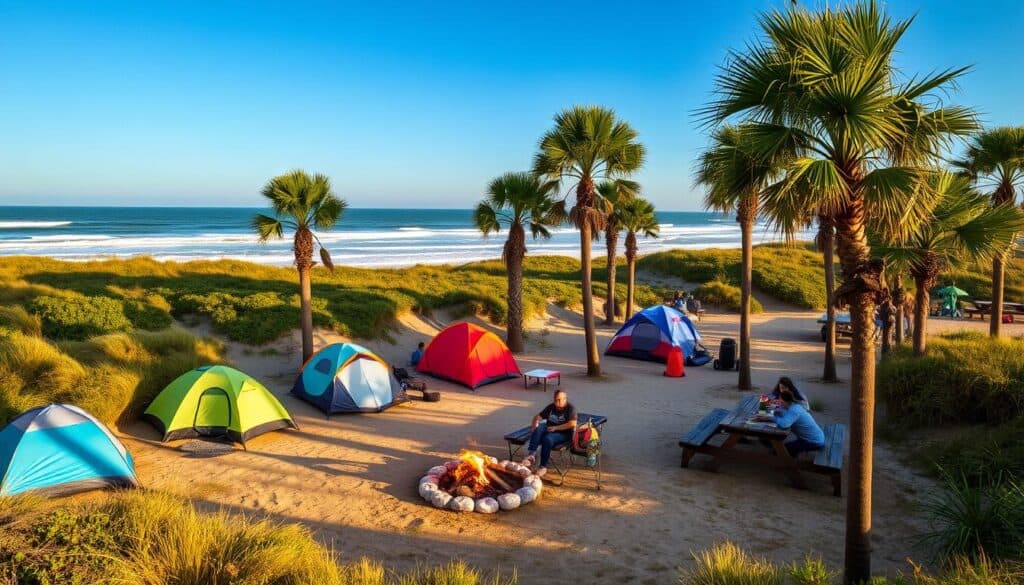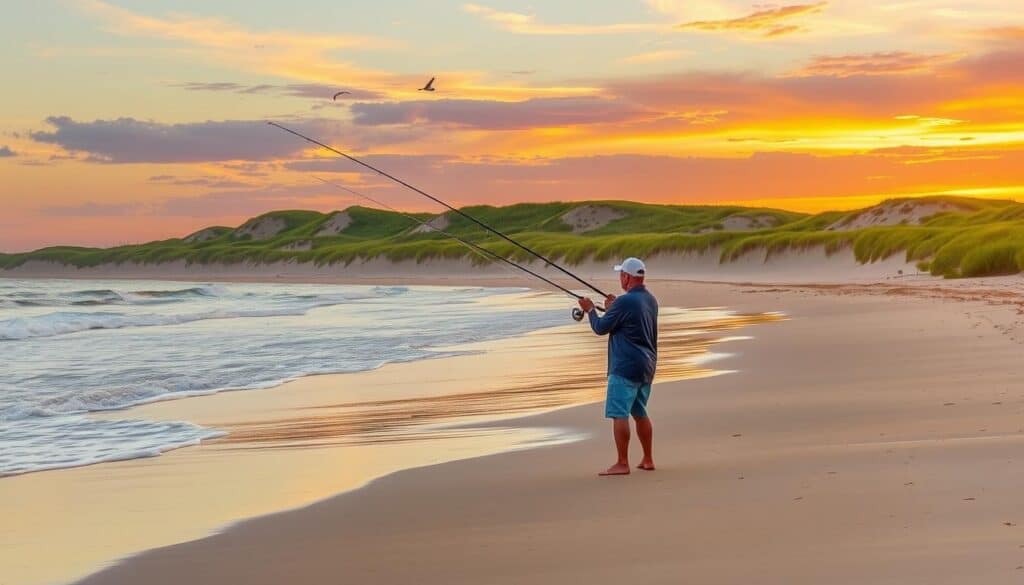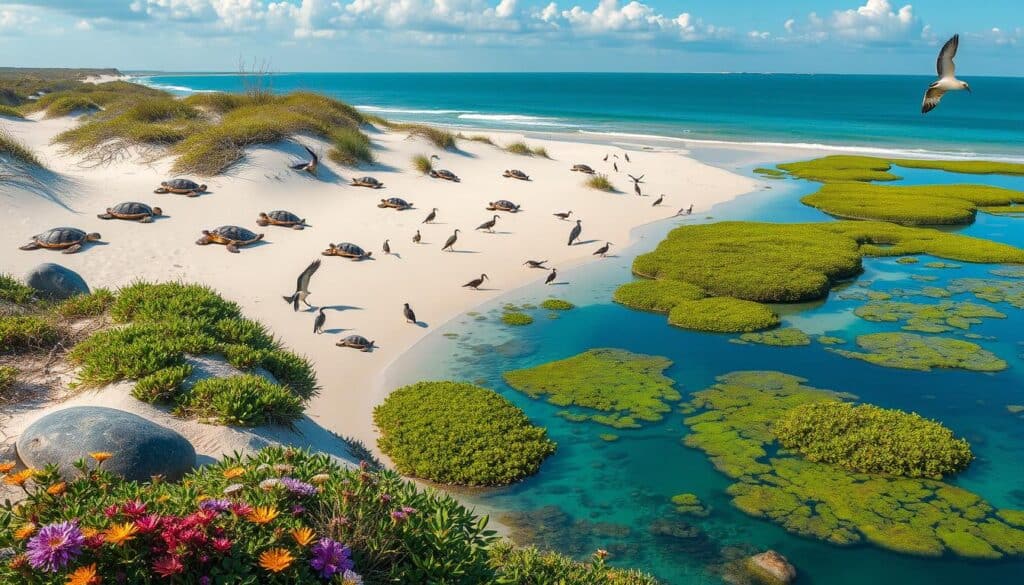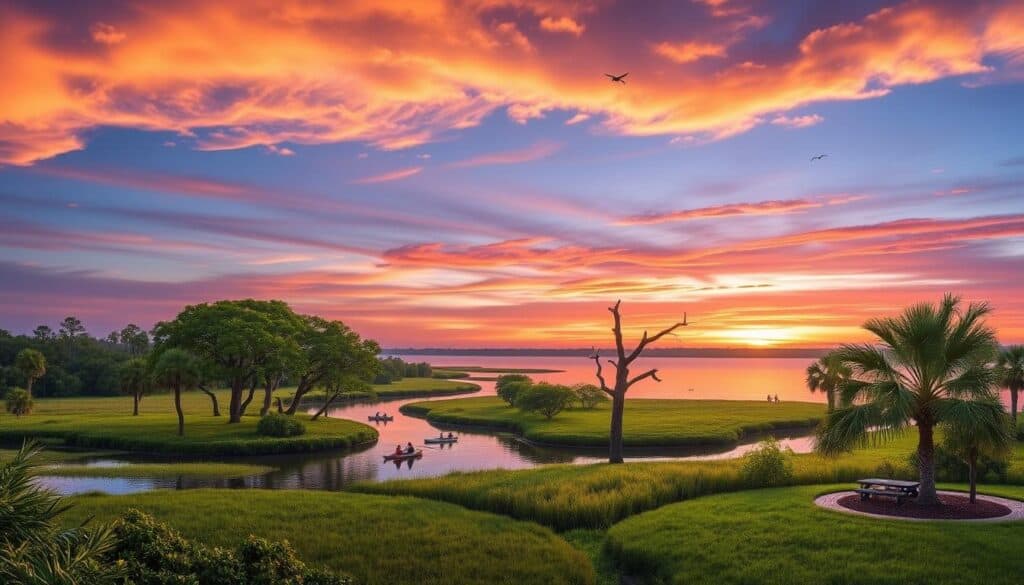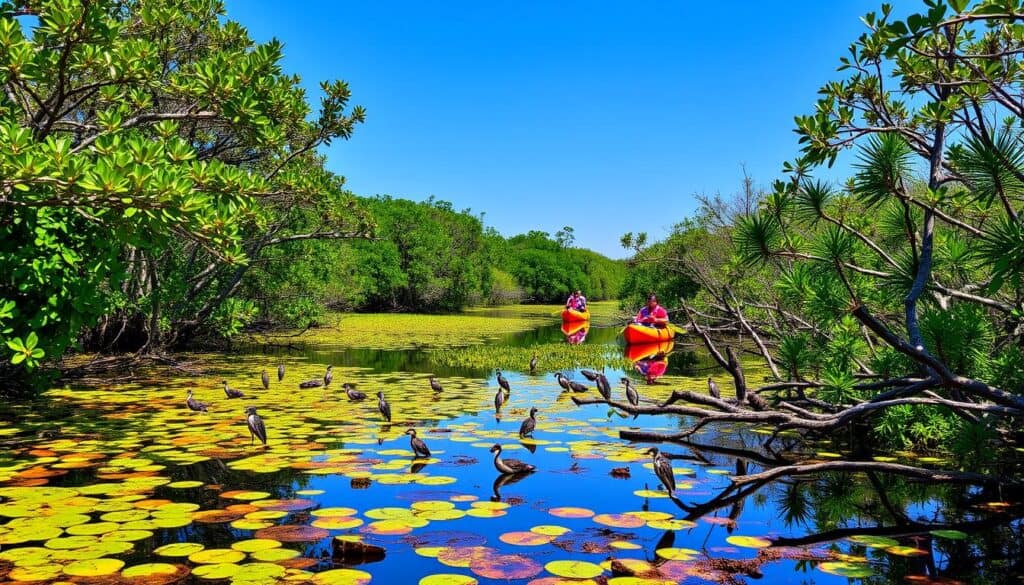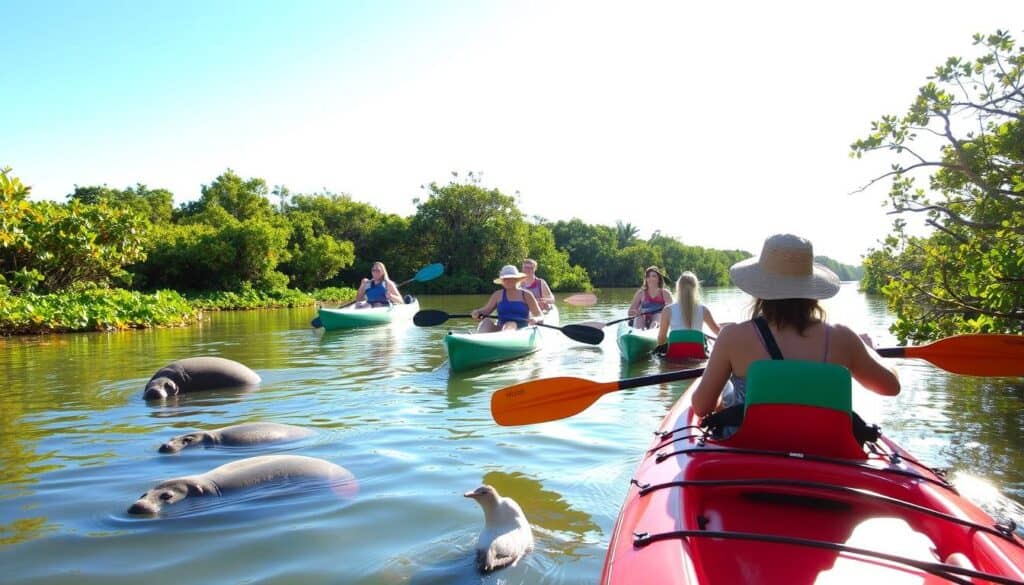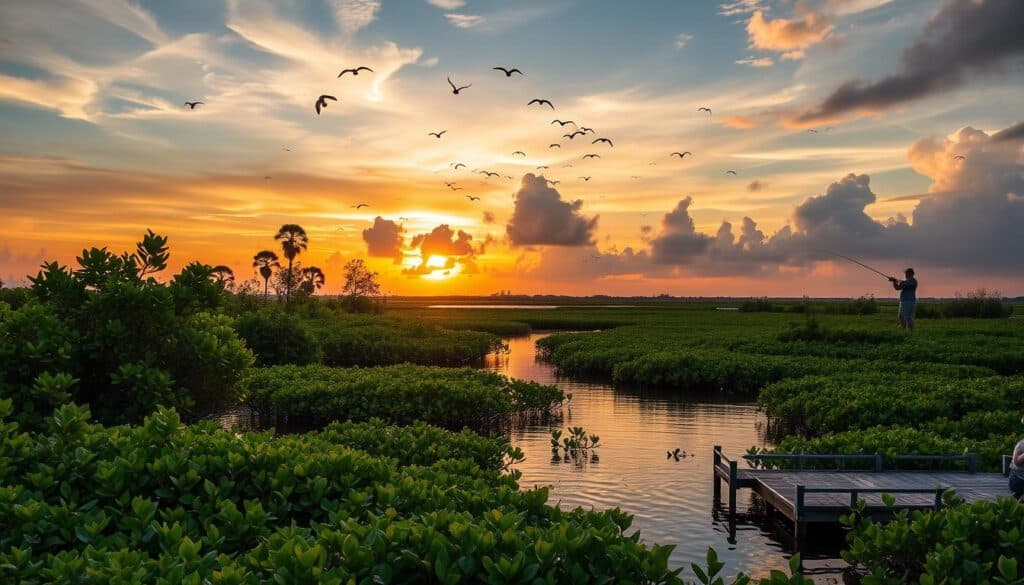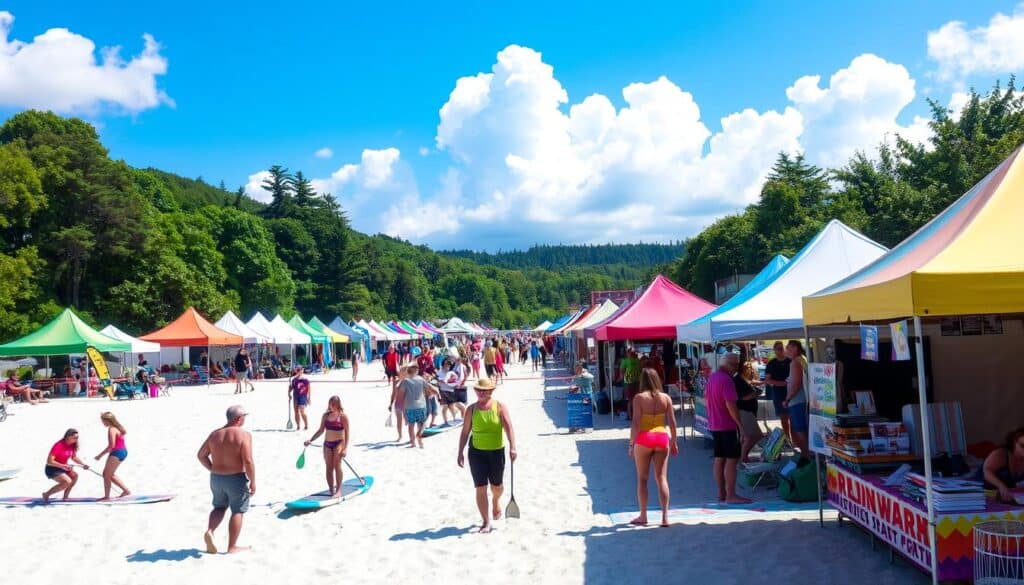Fort George Island Cultural State Park, one of the premier Florida state parks, is a unique blend of nature and culture in Jacksonville, Florida. This park offers a wide range of activities, including hiking, birdwatching, and immersive cultural experiences, making it a must-visit destination for outdoor enthusiasts and history buffs alike. Located at 12241 Fort George Rd, Jacksonville, FL 32226, Fort George Island Cultural State Park is easily accessible by various transportation methods, including public buses, bicycles, and walking.
Key Takeaways
- Fort George Island Cultural State Park is a unique blend of nature and culture in Jacksonville, Florida.
- The park offers a wide range of activities, including hiking, birdwatching, and immersive cultural experiences.
- Fort George Island Cultural State Park is one of the premier Florida state parks, located at 12241 Fort George Rd, Jacksonville, FL 32226.
- The park is easily accessible by various transportation methods, including public buses, bicycles, and walking.
- Visitors can enjoy guided tours, including a 4.4-mile loop bicycle ride and a 5-mile guided Segway trip through a mature maritime forest.
- Fort George Island Cultural State Park is part of the Great Florida Birding Trail, attracting a variety of bird species.
- The park is home to many migratory bird species, providing optimal birdwatching opportunities.
Introduction to Fort George Island Cultural State Park
Fort George Island Cultural State Park is a significant part of Jacksonville attractions, offering a glimpse into the region’s rich history. As one of the historic sites in Florida, it provides a unique opportunity to explore the state’s cultural heritage. The park’s history dates back to the Timucua chiefdom, with evidence of human presence spanning thousands of years.
The park is home to several historic sites, including the Spanish mission of San Juan del Puerto. This mission played a crucial role in the region’s history, and its legacy can still be seen today. Visitors to the park can learn about the mission’s significance and its impact on the local community.
- Historic sites, such as the Spanish mission of San Juan del Puerto
- Cultural exhibits and programs
- Opportunities for outdoor recreation, such as hiking and kayaking
These features make Fort George Island Cultural State Park a must-visit destination for anyone interested in Jacksonville attractions and historic sites in Florida.
A Brief History of the Park
The park’s history is a long and complex one, with multiple cultures and civilizations contributing to its development. From the Timucua chiefdom to the Spanish mission, each period has left its mark on the park. Visitors can learn about this history through exhibits and programs, gaining a deeper understanding of the park’s significance.
Importance of Cultural Heritage
The cultural heritage of Fort George Island Cultural State Park is a vital part of its identity. The park’s history and significance are a testament to the importance of preserving cultural heritage sites. By visiting the park, visitors can learn about the region’s history and culture, gaining a new appreciation for the importance of cultural heritage.
Location and Accessibility
Fort George Island Cultural State Park is conveniently located approximately 9 miles south of Amelia Island on S.R. A1A, making it an ideal spot for outdoor recreation in Jacksonville. The park’s proximity to other nature trails in Florida adds to its appeal, offering visitors a wide range of options for exploration and adventure.
The park is accessible via major roadways, specifically Heckscher Dr and Interstate 295 (I-295), and public transportation options are also available. For those who prefer to drive, the park’s address is 11241 Fort George Rd, Jacksonville, FL 32226.
Getting to the Park
Visitors can reach the park by car or by using public transportation. The park is within a three-mile radius of several attractions, including:
- Kingsley Plantation
- Little Talbot Island State Park
- Ribault Club
- Huguenot Memorial Park
The park’s location and accessibility make it an attractive destination for outdoor enthusiasts and nature lovers, offering opportunities to explore the beautiful nature trails in Florida and enjoy outdoor recreation in Jacksonville.
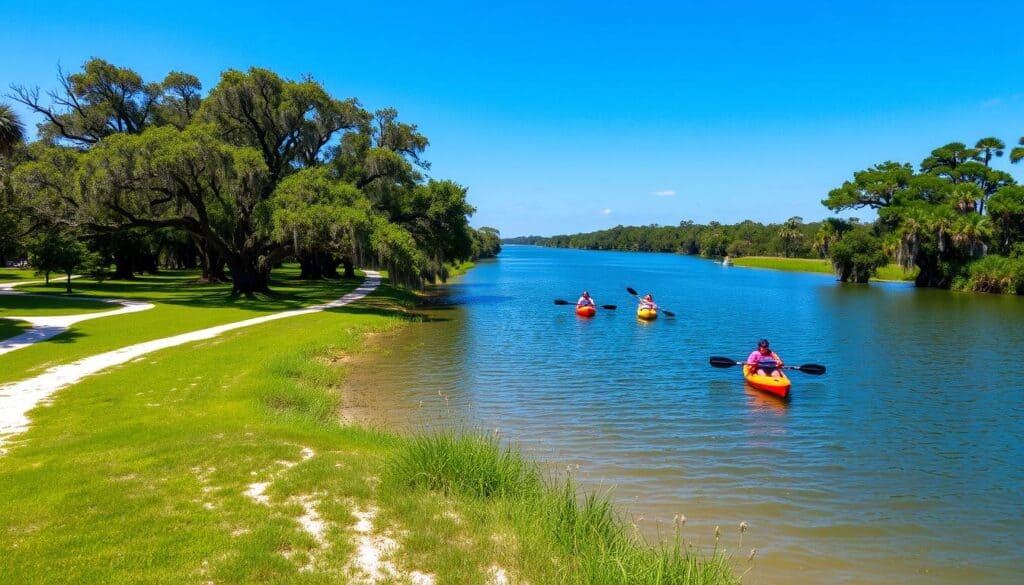
Activities to Enjoy at the Park
Fort George Island Cultural State Park offers a wide range of activities for visitors to enjoy. From hiking and birdwatching to kayaking and canoeing, there’s something for everyone. The park is a prime location for bird watching in Florida, with its diverse wildlife and natural habitats. Visitors can also enjoy a picnic at one of the many picnic spots in Jacksonville, making it a great day out for families and friends.
The park’s hiking trails offer a chance to explore the island’s natural beauty, with scenic views and historic landmarks along the way. For those interested in bird watching in Florida, the park is a must-visit, with its wide range of bird species and habitats. After a day of hiking and birdwatching, visitors can relax at one of the many picnic spots in Jacksonville, enjoying the beautiful scenery and each other’s company.
- Hiking and biking trails
- Kayaking and canoeing
- Birdwatching and wildlife viewing
- Picnicking and relaxing in nature
Whether you’re interested in outdoor adventures or simply want to relax in nature, Fort George Island Cultural State Park has something for everyone. With its rich history, natural beauty, and wide range of activities, it’s a must-visit destination for anyone looking to explore the best of bird watching in Florida and picnic spots in Jacksonville.
| Activity | Description |
|---|---|
| Hiking | Explore the island’s natural beauty on one of our many hiking trails |
| Birdwatching | Spot a wide range of bird species in their natural habitats |
| Kayaking and Canoeing | Paddle through the island’s waterways and enjoy the scenery |
Unique Features of Fort George Island
Fort George Island is a treasure trove of historic structures and natural beauty, making it a must-visit destination for anyone interested in exploring the Timucuan Preserve and other historic sites in Florida. The island’s unique features are a testament to its rich cultural heritage, with the remains of the Spanish mission being a notable highlight.
Some of the key features of the island include:
- Historic structures, such as the Spanish mission and other landmarks
- Scenic overlooks with breathtaking views of the surrounding natural beauty
- Opportunities to explore the island’s diverse wildlife and ecosystems
The island’s connection to the Timucuan Preserve is particularly significant, as it provides a glimpse into the region’s history and cultural significance. As one of the historic sites in Florida, Fort George Island is an important part of the state’s cultural heritage, and its natural beauty and scenic overlooks make it a popular destination for outdoor enthusiasts.

Overall, Fort George Island is a unique and fascinating destination that offers something for everyone. Whether you’re interested in history, nature, or simply want to explore a new and exciting place, the island is definitely worth a visit.
| Feature | Description |
|---|---|
| Historic Structures | Remains of the Spanish mission and other landmarks |
| Scenic Overlooks | Breathtaking views of the surrounding natural beauty |
| Wildlife and Ecosystems | Diverse range of plant and animal species |
Wildlife and Ecosystems
Fort George Island Cultural State Park is a haven for outdoor enthusiasts, offering a unique blend of outdoor recreation in Jacksonville and nature trails in Florida. The park’s diverse ecosystems, including marshland, hardwood hammocks, and saltwater marshes, provide a habitat for a wide range of native species.
The park’s role in conservation efforts is crucial, as it helps to protect and preserve the natural beauty of the area. Visitors can explore the park’s five miles of trails, which take them through various ecosystems and offer opportunities to spot local wildlife. The park’s conservation efforts are an important part of outdoor recreation in Jacksonville, making it a popular destination for nature lovers and outdoor enthusiasts.
Some of the native species found in the park include birds, fish, and mammals, which are an integral part of the ecosystem. The park’s conservation efforts help to ensure the long-term survival of these species, which is essential for maintaining the balance of nature. By visiting the park and participating in outdoor recreation in Jacksonville, visitors can contribute to the conservation efforts and help protect the natural beauty of the area.
Native Species of the Area
The park is home to a variety of native species, including the American alligator and the wood stork. These species are an important part of the ecosystem, and the park’s conservation efforts help to ensure their survival. Visitors can learn more about the native species and the park’s conservation efforts by participating in guided tours and educational programs.
Role in Conservation Efforts
Fort George Island Cultural State Park plays a vital role in conservation efforts, helping to protect and preserve the natural beauty of the area. The park’s conservation efforts are an important part of outdoor recreation in Jacksonville, making it a popular destination for nature lovers and outdoor enthusiasts. By visiting the park and participating in outdoor activities, such as hiking and birdwatching, visitors can contribute to the conservation efforts and help protect the natural beauty of the area.
Visitor Information
Planning a visit to Fort George Island Cultural State Park, one of the notable Florida state parks, requires some essential information. Visitors can find details on park hours, entrance fees, and available amenities to make the most of their trip.
The park is open from Wednesday to Sunday, with the visitor center operating from 9 AM to 5 PM. Admission to the park is free, making it an accessible destination for all. The visitor center offers a range of amenities, including a museum with a film, a gift shop, and picnic areas.
Park Hours and Entrance Fees
It’s worth noting that the park is closed on Thanksgiving and Christmas, so it’s a good idea to plan your visit around these holidays. The visitor center is a great place to start your day, with friendly staff on hand to provide information and answer any questions you may have.
Amenities Available on the Site
Some of the amenities available at Fort George Island Cultural State Park include Wi-Fi at the Visitor Center, group primitive campouts, and locations for weddings (site approval required). The park also offers a range of activities, such as birding, nature trails, kayaking, and canoe rental, making it a great destination for outdoor enthusiasts.
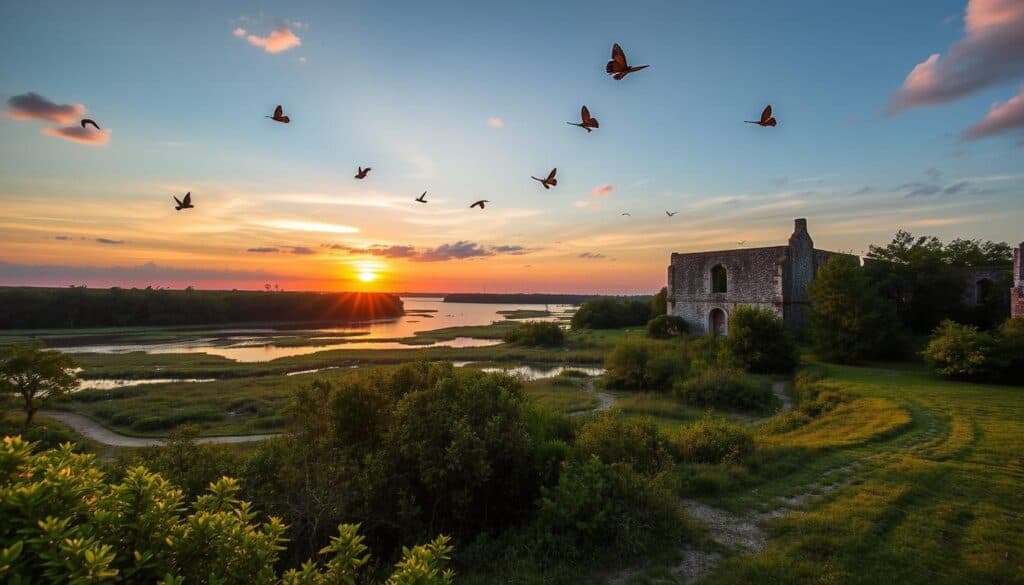
Whether you’re interested in history, nature, or simply want to spend a day outdoors, Fort George Island Cultural State Park has something for everyone. With its rich cultural heritage and natural beauty, it’s a must-visit destination for anyone exploring Florida state parks.
Educational Resources
Fort George Island Cultural State Park is one of the top Jacksonville attractions, offering a wide range of educational resources for visitors to learn about its rich history and cultural significance. As one of the historic sites in Florida, the park provides a unique opportunity for visitors to explore and discover its importance.
The park offers guided tours and programs, which are designed to educate visitors about the island’s history, cultural significance, and natural environment. These tours and programs are led by experienced guides who are knowledgeable about the park’s history and can provide valuable insights and information to visitors.
Guided Tours and Programs
Some of the guided tours and programs available at the park include a two-hour guided driving tour that incorporates an audio tour, which provides visitors with a comprehensive overview of the park’s history and cultural significance. Visitors can also participate in guided walks and hikes, which allow them to explore the park’s natural environment and learn about its unique flora and fauna.
Interpretive Exhibits
The park also features interpretive exhibits, which provide visitors with a deeper understanding of the park’s history and cultural significance. These exhibits include descriptive panels and an audio tour, which are available at the visitor center and throughout the park. The exhibits are designed to be interactive and engaging, making them a great resource for visitors of all ages.

Overall, Fort George Island Cultural State Park is a valuable educational resource for visitors, providing a unique opportunity to learn about its rich history and cultural significance. As one of the top Jacksonville attractions and historic sites in Florida, the park is a must-visit destination for anyone interested in learning about the state’s history and cultural heritage.
Community Events and Programs
The park hosts various community events and programs, contributing to outdoor recreation in Jacksonville. One notable event is the annual Talbot Tidewater Celebration, which takes place on National Public Lands Day. This event features a Junior Ranger Angler Fishing Clinic, where kids can learn skills like casting, knot tying, and ethical angling.
Some of the activities and features of the event include:
- Exhibit displays
- Guided hikes
- A kids’ fun run
- Local and state conservation exhibitors
- Food for purchase or picnic lunch options
These events enhance the park’s role in outdoor recreation in Jacksonville and its connection to nature trails in Florida, promoting a sense of community and appreciation for the natural environment.
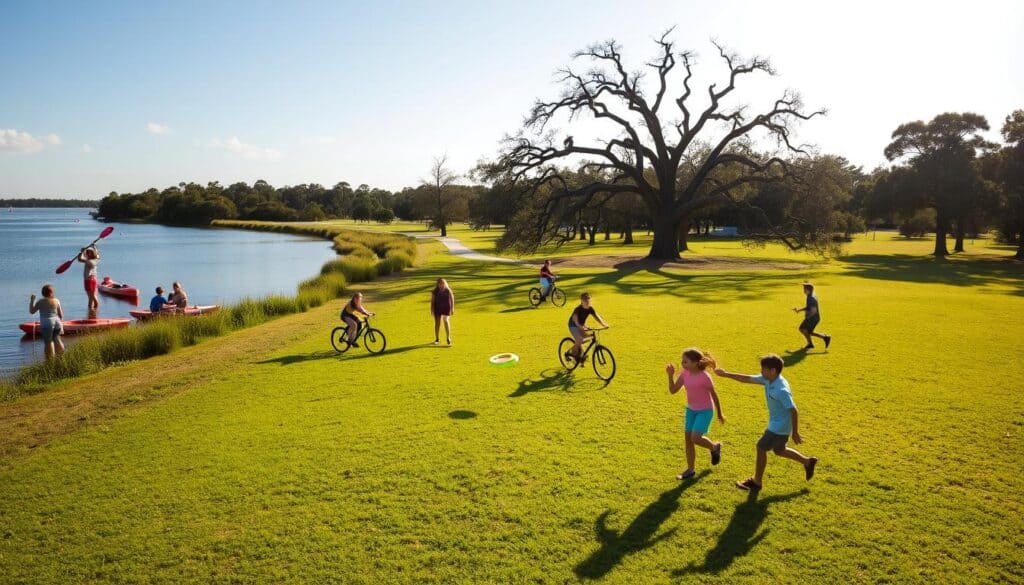
The park’s community events and programs are made possible by organizations like the Friends of Talbot Islands State Parks, which provides funding and support for various projects and equipment. By participating in these events, visitors can experience the beauty of nature trails in Florida and contribute to the preservation of the park’s natural resources.
| Event | Date | Time |
|---|---|---|
| Talbot Tidewater Celebration | September 28 | 10 a.m. – 3 p.m. |
Important Tips for Visitors
As you plan your visit to Fort George Island Cultural State Park, it’s essential to be prepared for a day of exploration and adventure. Whether you’re interested in bird watching in Florida or simply looking for a relaxing picnic spots in Jacksonville, this park has something for everyone.
To make the most of your visit, consider bringing binoculars for bird watching in Florida, as well as a picnic lunch to enjoy at one of the many picnic spots in Jacksonville within the park. Don’t forget to pack plenty of water, sunscreen, and comfortable walking shoes.
What to Bring for a Day at the Park
- Binoculars for bird watching
- Picnic lunch and refreshments
- Water and sunscreen
- Comfortable walking shoes
Leave No Trace Principles
To help preserve the park’s natural beauty, remember to follow Leave No Trace principles. This includes disposing of trash properly, staying on designated trails, and respecting wildlife habitats. By doing so, you’ll help ensure that Fort George Island Cultural State Park remains a beautiful and thriving destination for bird watching in Florida and other outdoor activities.
By following these simple tips and guidelines, you’ll be well on your way to a fun and memorable visit to Fort George Island Cultural State Park. Enjoy your time exploring this unique and fascinating destination, and don’t forget to take in the stunning natural beauty of the surrounding area, perfect for picnic spots in Jacksonville.
| Activity | Best Time |
|---|---|
| Bird watching | Early morning or late afternoon |
| Picnicking | Any time of day |
Environment and Preservation Efforts
The Timucuan Preserve is a vital part of the historic sites in Florida, and its preservation is crucial for maintaining the state’s natural and cultural heritage. The park’s involvement in ongoing restoration projects highlights its commitment to environmental preservation and its connection to the Timucuan Preserve.
Some of the preservation efforts include:
- Protecting local flora and fauna
- Restoring natural habitats and ecosystems
- Promoting sustainable practices and environmental awareness
The Timucuan Preserve is an example of the importance of preserving historic sites in Florida, and the park’s efforts to protect the environment and promote sustainability are essential for maintaining the state’s natural beauty and cultural significance.
By supporting preservation efforts and visiting historic sites like the Timucuan Preserve, individuals can contribute to the protection of Florida’s natural and cultural heritage, ensuring that these treasures are preserved for future generations to enjoy.
Nearby Attractions
Visitors to Fort George Island Cultural State Park can explore a variety of nearby attractions, making it a central point for discovering the beauty of Florida state parks. The park’s location provides easy access to other parks, nature reserves, and cultural sites, offering a wealth of opportunities for outdoor recreation and cultural enrichment.
Some popular nearby attractions include the Saint George Island Lighthouse, Bob Sikes Cut, and the Ribault Club. The Saint George Island Lighthouse features 92 stairs to the top, offering breathtaking views of the surrounding area. Bob Sikes Cut is a significant fishing spot, known for its abundance of flounder, catfish, rock bass, and bonnetheads. The Ribault Club, situated on 100 acres of land, is recognized as the largest wooden structure in northeast Florida and is listed on the National Register of Historic Places.
Other Parks and Nature Reserves
- Little Talbot Island State Park
- Big Talbot Island State Park
- Timucuan Ecological and Historic Preserve
Cultural Sites in the Vicinity
Visitors can also explore the rich cultural heritage of the area by visiting nearby cultural sites, such as the Kingsley Plantation and the Fort Caroline National Memorial. These sites offer a glimpse into the region’s history and provide a deeper understanding of the area’s cultural significance.
With its unique blend of natural beauty, outdoor recreation, and cultural enrichment, Fort George Island Cultural State Park is the perfect destination for anyone looking to experience the best of Florida state parks.
| Attraction | Location | Description |
|---|---|---|
| Saint George Island Lighthouse | Saint George Island | 92 stairs to the top, offering breathtaking views |
| Bob Sikes Cut | Fort George Island | Significant fishing spot, known for flounder, catfish, rock bass, and bonnetheads |
| Ribault Club | Fort George Island | Largest wooden structure in northeast Florida, listed on the National Register of Historic Places |
Conclusion: Why You Should Visit Fort George Island
Fort George Island Cultural State Park is a true gem among the Jacksonville attractions offering exceptional outdoor recreation in Jacksonville. This captivating destination blends natural beauty, cultural significance, and a wealth of engaging activities, making it a must-visit for anyone seeking to immerse themselves in the region’s rich history and untouched landscapes.
Recap of Key Highlights
From the park’s 40 miles of pristine shoreline and 10,000 acres of unspoiled vistas to the historic Kingsley Plantation and the fascinating story of its enslaved communities, Fort George Island is a treasure trove of experiences. Visitors can explore hiking trails, spot diverse wildlife, and even enjoy fishing on the 1-mile-long pedestrian bridge.
Encouragement to Experience Its Beauty
Whether you’re a nature enthusiast, history buff, or simply seeking a peaceful escape, Fort George Island Cultural State Park offers something for everyone. Its natural beauty, cultural significance, and wealth of recreational activities make it a standout among the Jacksonville attractions and a must-visit destination for outdoor recreation in Jacksonville. So, plan your visit today and discover the captivating wonders of this remarkable park.
FAQ
What is the history and cultural significance of Fort George Island Cultural State Park?
Fort George Island Cultural State Park has a rich history, dating back to its role as one of the historic sites in Florida. The park is known for its cultural heritage, which is crucial in understanding its value and the role it plays in preserving Jacksonville’s attractions.
How can I get to the park and what are the nearby attractions?
The park is easily accessible, with driving directions and public transportation options available. It is also conveniently located near other nature trails in Florida, making it an ideal spot for outdoor recreation in Jacksonville.
What activities can I enjoy at Fort George Island Cultural State Park?
The park offers a variety of activities, including hiking trails, birdwatching opportunities, and kayaking/canoeing. It is a prime location for bird watching in Florida and one of the picnic spots in Jacksonville.
What are the unique features and landmarks of the park?
Fort George Island is home to historic structures and landmarks, scenic overlooks, and natural beauty. The park is closely connected to the Timucuan Preserve and is considered one of the historic sites in Florida.
What kind of wildlife and ecosystems can I find at the park?
The park is teeming with native species and plays a crucial role in conservation efforts. It contributes to the outdoor recreation in Jacksonville and is part of the extensive nature trails in Florida.
What visitor information and amenities are available at the park?
Fort George Island Cultural State Park offers a range of visitor amenities, including park hours, entrance fees, and on-site facilities. This information can help you plan your visit to one of the notable Florida state parks.
What educational resources and community events are offered at the park?
The park provides educational resources, such as guided tours, programs, and interpretive exhibits, making it a valuable educational destination among the historic sites in Florida and Jacksonville attractions.
What should I bring and what guidelines should I follow during my visit?
Visitors should come prepared with the necessary items for a day at the park, and it is essential to adhere to Leave No Trace principles to help preserve the natural beauty of the park, which is a great spot for bird watching in Florida and one of the ideal picnic spots in Jacksonville.
How is the park involved in environmental preservation efforts?
Fort George Island Cultural State Park is committed to protecting the local flora and fauna, and it is actively engaged in ongoing restoration projects to preserve the natural beauty of the Timucuan Preserve and its status as one of the historic sites in Florida.


